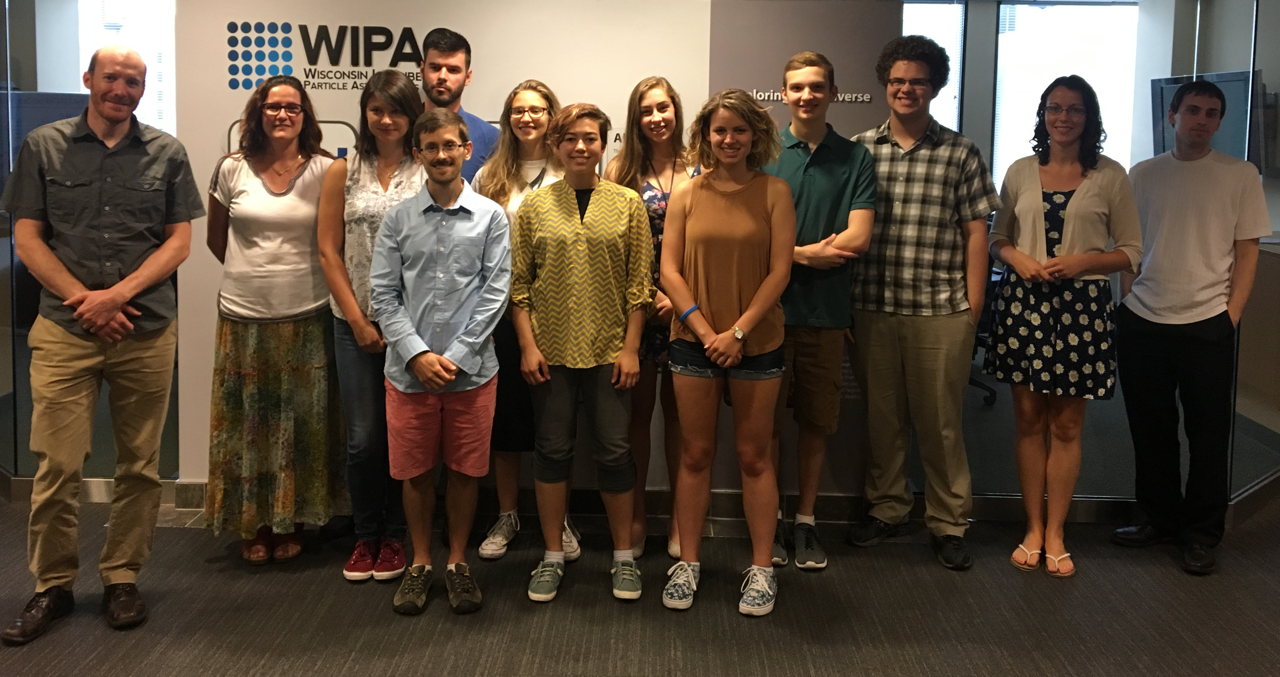In the northwest corridor at WIPAC, voices are sporadic once again. The open work area next to the help desk team is now mostly dark with empty tables and bare walls. But it has not always been like this. Certainly not during the last few weeks, when this space was one of the most active areas on the floor.
Elsa, Haley, Marcus, Blake, and Emme—see them in the image below—came from West and East High Schools in Madison, Middleton High School, and Oregon High School. Theirs were the voices filling up the corridor during six tireless, inspiring, and fun weeks. For the third year in a row, WIPAC hosted a summer internship, and once again, interns showed that they have what it takes to be good researchers and that—if they wish—they could be part of the next generation of scientists.

Hard work along with some laughter was the way they faced challenging projects that drove them to learn about astrophysics at an advanced pace. They boosted their coding skills along the way, as they embarked on enterprising collaborative research. They were moving forward together, honing their individual skills at the same time. They enjoyed every minute, especially savoring each little success after any new hindrance.
They worked on a brand-new, multimessenger astronomy sky map, built and took data with the Cosmic Watch detectors, and developed web-based analysis tools for the DECO app—a citizen science project that turns cell phones into particle detectors. The sky map is not yet published, but it will be online soon.
“I had myriad experiences which exposed me to the collaborative processes that occur within research projects. It has opened me up to the real world scientific community of learning, failing, and persevering,” says Emme Hannibal, a student from Oregon High School.
“The weekly feedback and availability of our mentors was especially useful. I can’t count the number of times a quick trip down the hall saved me hours of stagnation,” explains Elsa Forberger, a student at West High School in Madison.
“I first applied to this internship with the hope of exploring the field of particle physics and I experienced not only that, but I also gained legitimate experience in a scientific environment,” says Haley James, also a student at West High School.
“Working in a genuine research environment this summer confirmed my desire to pursue physics in college,” adds Blake Gallay, a student at Middleton High School.
“It’s been a transformative experience. I would strongly recommend that every high school student interested in physics apply to opportunities like this internship,” says Marcus Graham, a student at East High School in Madison.

What makes this internship such a great program is that everyone enjoys it, even mentors who carve out some time for the students during their busy summer, when they are also travelling to conferences and focusing on their research, taking advantage of the break from classes.
“This internship was a new program for me. And the interns positive attitude and skills showed me right away that this was going to be a cool project to work on,” says Josh Wood, a postdoctoral researcher at WIPAC. “After just a couple of weeks working together, we had a research team in full swing.”
“This high school internship has been an important part of DECO since 2015. Again this summer I’m impressed by how enthusiastic, creative, and productive the students have been,” explains Justin Vandenbroucke, an assistant professor at UW–Madison and principal investigator of the DECO project.
“Cosmic Watch is a project aimed at bringing portable cosmic ray detectors into the classroom. The internship allowed us to test possible research projects for the classroom and teach students about particle physics and electronics design,” explains Spencer Axani, an MIT graduate student based in Madison who leads the Cosmic Watch project.
“Working with this group of talented students was a fantastic experience and they gave me new insights into working with my own classes. This group definitely proved that high school students can do some amazing things when given the opportunity,” says Amanda Nothem, a high school teacher at Whitnall High School near Milwaukee.
Interns are no longer showing up in the office every day, but their voices still reverberate in the northwest corridor. Regardless of how much they did, there is still more in the pipeline. They discussed plans to push their projects further, and maybe the fall will bring new opportunities for them.
In the meantime, WIPAC will continue looking for ways to work with students and teachers. “We host the UW–Madison QuarkNet Center, and this internship is at the core of the program,” says Sílvia Bravo, who co-leads the QuarkNet Center in Madison with Vandenbroucke. “Training the future generation of scientists is part of WIPAC’s mission. I wish we could host more interns!” adds Bravo.
